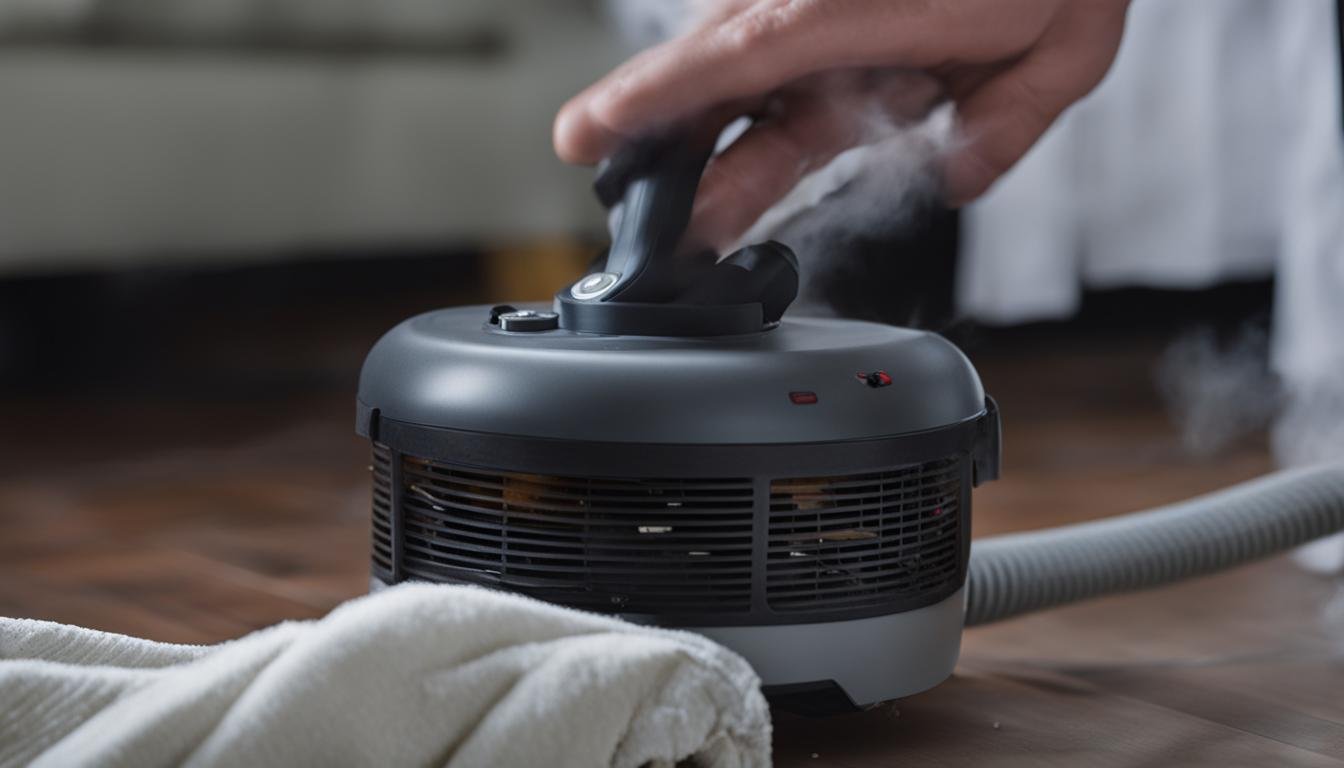If you’ve noticed that your vacuum cleaner is overheating and causing issues, don’t worry. There are simple tricks and tips you can follow to fix the problem and prevent it from happening again. As an expert in vacuum cleaner troubleshooting, I’m here to guide you through the process.
First, it’s important to understand the signs of an overheating vacuum cleaner. Some common indications include a burning smell, loss of suction power, or the motor shutting off unexpectedly. If you notice any of these symptoms, it’s time to take action.
One of the most common causes of vacuum cleaner overheating is a lack of proper airflow. When the airflow is restricted, the motor has to work harder, leading to overheating. So, let’s start by checking the bag or canister. If it’s full, empty it to ensure proper airflow. Additionally, if your vacuum cleaner has a filter, clean or replace it to prevent clogging.
Next, inspect the hose, attachments, and brushes for any debris that may be obstructing the airflow. Clear out any blockages or tangled hair that may have accumulated over time. This will allow the air to flow freely and prevent the vacuum cleaner from overheating.
In some cases, damaged parts can also contribute to the overheating issue. Check for cracked belts, worn-out brushes, or any other damaged components that may be impeding the system. If you spot any issues, replace the damaged parts to ensure smooth operation.
Lastly, regular maintenance is essential to maintain a cool vacuum cleaner. Clean or replace the air filter frequently, as clogged filters can significantly impact airflow. Additionally, empty the bag or canister and remove any debris from the brush and attachments after each use. By following these simple maintenance practices, you can prevent your vacuum cleaner from overheating in the future.
Key Takeaways:
- Check if the bag or canister is full and empty it if necessary to ensure proper airflow.
- Clear out any debris that may be blocking the hose, attachments, and brushes.
- Inspect for any damaged parts, such as cracked belts, and replace them if necessary.
- Clean or replace the air filter regularly to prevent clogging and improve airflow.
- Perform regular maintenance, such as cleaning filters and emptying bags, to prevent overheating issues in the future.
Troubleshooting Low Suction Force in a Vacuum Cleaner
One common problem with vacuum cleaners is low suction force, which can make them less effective. There are several possible causes for this issue. It could be due to a blocked filter, a full vacuum bag, a blockage in the floor head, neck, or hose, or a clogged brush.
To fix low suction force, follow these troubleshooting steps:
- Clean or replace the filter: A blocked filter can impede airflow and reduce suction power. Remove the filter and clean it according to the manufacturer’s instructions. If the filter is damaged or excessively dirty, consider replacing it.
- Empty or replace the vacuum bag: A full vacuum bag can restrict airflow and lead to low suction. Check the bag and empty it if necessary. If you’re using a bagless vacuum cleaner, empty the dust container. If the bag is already empty, replace it with a new one.
- Clear any blockages: Check for blockages in the floor head, neck, or hose. Disconnect the hose and use a long, flexible object like a broom handle to gently push through the hose, clearing any debris or obstructions. You can also use a straightened wire hanger to remove clogs from the hose.
- Clean the brush: A clogged brush can prevent proper suction. Remove the brush from the vacuum cleaner and remove any tangled hair, threads, or debris. Use scissors or a seam ripper to carefully cut and remove any stubborn clogs.
By addressing these potential causes, you can restore proper suction power to your vacuum cleaner and ensure it operates efficiently.
Remember, regular maintenance and cleaning are key to preventing low suction force in your vacuum cleaner. By performing these troubleshooting steps as needed, you can keep your vacuum cleaner in optimal working condition and maintain a clean home.
Dealing with Excessive Noise from Your Vacuum Cleaner

Excessive noise coming from your vacuum cleaner can not only be bothersome but may also indicate underlying issues that need attention. The constant racket can disrupt your cleaning routine and even disturb others in the vicinity. To restore a quieter vacuuming experience, it’s important to identify and address the root causes of this excessive noise.
Common Causes of Excessive Noise
- Blockage: A blockage in the floor head, neck, or hose of your vacuum cleaner can significantly contribute to the noise. It can restrict the airflow and force the motor to work harder, resulting in increased noise levels.
- Motor Problems: Various motor-related issues, such as detachments in the belt or hose, can cause abnormal noises during operation. These problems can arise due to wear and tear or improper maintenance, impacting the overall performance of your vacuum cleaner.
- Air Leaks: Air leaks within the vacuum cleaner can create unwanted noise as air rushes through openings or gaps in the system. These leaks can occur in different parts, including seals, connections, or even the hose itself.
Addressing the Issues
To effectively tackle the excessive noise and bring tranquility back to your cleaning routine, follow these troubleshooting steps:
Step 1: Check for Blockages
Inspect the floor head, neck, and hose for any visible blockages. Remove any debris or clogs that may be obstructing the airflow. This simple action can often alleviate the excess noise and improve the overall suction power of your vacuum cleaner.
Step 2: Inspect the Motor
Carefully examine the motor area for any signs of detachment in the belt or hose. If you notice any loose or damaged components, tighten or replace them accordingly. This step may require referring to the manufacturer’s instructions or seeking professional assistance.
Step 3: Seal or Replace Air Leaks
If you suspect air leaks in your vacuum cleaner, inspect the seals, connections, and hose for any gaps or damage. Seal any openings using appropriate adhesive or, if necessary, replace the affected parts.
By addressing these potential causes of excessive noise, you can enjoy a more peaceful vacuuming experience while ensuring the optimal performance and longevity of your vacuum cleaner.
Remember, regular maintenance and cleaning are key to preventing potential issues like excessive noise. By following the manufacturer’s recommendations and practicing routine care, you can keep your vacuum cleaner running smoothly and quietly for years to come.
Conclusion
When it comes to vacuum cleaner problems like overheating, low suction force, excessive noise, and other issues, simple fixes are often available. By following the troubleshooting steps outlined in this article, you can effectively address these common problems and maintain your vacuum cleaner in optimal working condition.
Regular maintenance is key to preventing these issues from occurring in the future. Make sure to clean filters and empty bags on a regular basis to maintain proper airflow and suction power. Additionally, check for any blockages in the hose, attachments, and brushes, and clear them out as necessary.
However, if you encounter more serious or persistent problems, it may be necessary to seek professional assistance or consider replacing your vacuum cleaner. Addressing these issues promptly will prolong the lifespan of your vacuum and ensure that it continues to deliver reliable performance.
FAQ
How can I fix an overheating vacuum cleaner?
To fix an overheating vacuum cleaner, start by checking if the bag or canister is full and empty it if necessary. Clear out any debris that may be blocking the hose, attachments, and brushes. Check for any damaged parts, such as cracked belts, that may be impeding the system. Clean or replace the air filter to prevent clogging and improve airflow.
What are the signs of an overheating vacuum cleaner?
Signs of an overheating vacuum cleaner include a burning smell, loss of suction power, and the vacuum shutting off unexpectedly. If you notice any of these signs, it’s important to address the issue promptly to prevent further damage.
What are the common causes of vacuum cleaner overheating?
Common causes of vacuum cleaner overheating include a full bag or canister, blockages in the hose or attachments, damaged parts such as belts or brushes, and a clogged air filter. These issues can restrict airflow and cause the vacuum cleaner to overheat.
How can I prevent my vacuum cleaner from overheating?
To prevent your vacuum cleaner from overheating, make sure to regularly empty the bag or canister, clean out any debris from the hose and attachments, and replace damaged parts. Additionally, clean or replace the air filter as recommended by the manufacturer.
How do I cool down a hot vacuum cleaner?
If your vacuum cleaner is hot, turn it off and unplug it from the electrical outlet. Allow it to cool down for at least 30 minutes before attempting to use it again. Avoid running the vacuum for extended periods without giving it breaks to cool down.
Should I seek professional help if my vacuum cleaner keeps overheating?
If your vacuum cleaner continues to overheat after you have tried the troubleshooting steps, it may be necessary to seek professional assistance. They can diagnose and fix any underlying issues that may be causing the overheating.





Leave a Reply